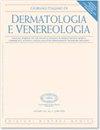Cutaneous tricholemmal carcinoma: a 15-years single centre experience.
IF 2
Q3 Medicine
Giornale Italiano Di Dermatologia E Venereologia
Pub Date : 2020-10-16
DOI:10.23736/S0392-0488.20.06672-9
引用次数: 0
Abstract
BACKGROUND Clear cell morphology has been described in several cutaneous neoplasms either as a specific feature of some entities either as a morphological variant in the spectrum, and these two entities are frequently considered together in the differential diagnosis. METHODS We reviewed our series of cases occurred in our laboratory in order to further quantify the number of cases showing morphological features of tricholemmal differentiation and to investigate other clinical or histological difference. We retrieved 91 cases and, for each of them, all the clinical data regarding age, sex, clinical features, and clinical suspicious were collected, when available. RESULTS The revision of the specimens concluded with a final diagnosis of tricholemmal carcinoma in 15 cases (17%), all the other cases were thus considered as squamous cell carcinoma with clear cell features. No statistically significant correlations were observed with the demografic or clinicopatholagical parameters such as age, sex or dimensions, but morphological revision highlighted a potentially greater "vertical" growth frequently not matched by a concomitant radial one in tricholemmal carcinoma than in squamous tumors. CONCLUSIONS The debate upon the diagnostic distinction of these tumours is still ongoing with authors proposing the tricholemmal carcinoma as a variant of a squamous cell carcinoma rather than a distinct entity. Further studies are needed to confirm our data and to evaluate the reproducibility of this feature.皮肤滴管癌:15年的单中心经验。
背景:在几种皮肤肿瘤中,透明细胞形态被描述为某些实体的特定特征,或者是光谱中的形态变异,这两种实体经常被认为是鉴别诊断的共同因素。方法回顾本实验室发生的一系列病例,以进一步量化表现出滴管分化形态特征的病例数量,并探讨其他临床或组织学差异。我们检索了91例病例,并收集了每个病例的所有临床资料,包括年龄、性别、临床特征和临床可疑性。结果15例(17%)经标本修订最终诊断为滴管癌,其余均为具有透明细胞特征的鳞状细胞癌。与人口统计学或临床病理参数(如年龄、性别或体型)没有统计学上的显著相关性,但形态学修正强调,与鳞状肿瘤相比,口孔癌的潜在“垂直”生长往往与伴随的放射状生长不匹配。结论:关于这些肿瘤的诊断区别的争论仍在进行中,作者提出口孔癌是鳞状细胞癌的一种变体,而不是一个独特的实体。需要进一步的研究来证实我们的数据,并评估这一特征的可重复性。
本文章由计算机程序翻译,如有差异,请以英文原文为准。
求助全文
约1分钟内获得全文
求助全文
来源期刊

Giornale Italiano Di Dermatologia E Venereologia
DERMATOLOGY-
CiteScore
1.90
自引率
0.00%
发文量
0
审稿时长
6-12 weeks
期刊介绍:
The journal Giornale Italiano di Dermatologia e Venereologia publishes scientific papers on dermatology and sexually transmitted diseases. Manuscripts may be submitted in the form of editorials, original articles, review articles, case reports, therapeutical notes, special articles and letters to the Editor.
Manuscripts are expected to comply with the instructions to authors which conform to the Uniform Requirements for Manuscripts Submitted to Biomedical Editors by the International Committee of Medical Journal Editors (www.icmje.org). Articles not conforming to international standards will not be considered for acceptance.
 求助内容:
求助内容: 应助结果提醒方式:
应助结果提醒方式:


